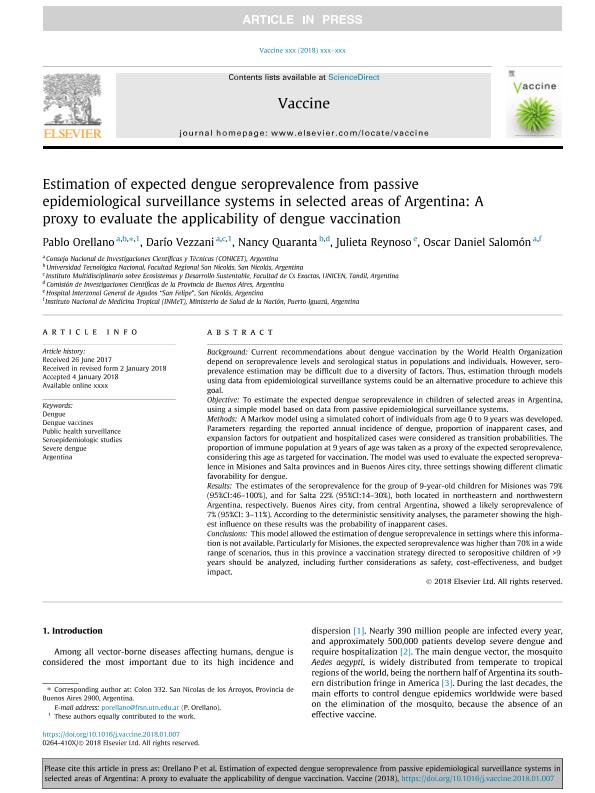Mostrar el registro sencillo del ítem
dc.contributor.author
Orellano, Pablo Wenceslao

dc.contributor.author
Vezzani, Dario

dc.contributor.author
Quaranta, Nancy Esther

dc.contributor.author
Reynoso, Julieta
dc.contributor.author
Salomón, Oscar Daniel

dc.date.available
2019-09-27T20:55:21Z
dc.date.issued
2018-02
dc.identifier.citation
Orellano, Pablo Wenceslao; Vezzani, Dario; Quaranta, Nancy Esther; Reynoso, Julieta; Salomón, Oscar Daniel; Estimation of expected dengue seroprevalence from passive epidemiological surveillance systems in selected areas of Argentina: A proxy to evaluate the applicability of dengue vaccination; Elsevier; Vaccine; 36; 7; 2-2018; 979-985
dc.identifier.issn
0264-410X
dc.identifier.uri
http://hdl.handle.net/11336/84733
dc.description.abstract
Background: Current recommendations about dengue vaccination by the World Health Organization depend on seroprevalence levels and serological status in populations and individuals. However, seroprevalence estimation may be difficult due to a diversity of factors. Thus, estimation through models using data from epidemiological surveillance systems could be an alternative procedure to achieve this goal. Objective: To estimate the expected dengue seroprevalence in children of selected areas in Argentina, using a simple model based on data from passive epidemiological surveillance systems. Methods: A Markov model using a simulated cohort of individuals from age 0 to 9 years was developed. Parameters regarding the reported annual incidence of dengue, proportion of inapparent cases, and expansion factors for outpatient and hospitalized cases were considered as transition probabilities. The proportion of immune population at 9 years of age was taken as a proxy of the expected seroprevalence, considering this age as targeted for vaccination. The model was used to evaluate the expected seroprevalence in Misiones and Salta provinces and in Buenos Aires city, three settings showing different climatic favorability for dengue. Results: The estimates of the seroprevalence for the group of 9-year-old children for Misiones was 79% (95%CI:46–100%), and for Salta 22% (95%CI:14–30%), both located in northeastern and northwestern Argentina, respectively. Buenos Aires city, from central Argentina, showed a likely seroprevalence of 7% (95%CI: 3–11%). According to the deterministic sensitivity analyses, the parameter showing the highest influence on these results was the probability of inapparent cases. Conclusions: This model allowed the estimation of dengue seroprevalence in settings where this information is not available. Particularly for Misiones, the expected seroprevalence was higher than 70% in a wide range of scenarios, thus in this province a vaccination strategy directed to seropositive children of >9 years should be analyzed, including further considerations as safety, cost-effectiveness, and budget impact.
dc.format
application/pdf
dc.language.iso
eng
dc.publisher
Elsevier

dc.rights
info:eu-repo/semantics/openAccess
dc.rights.uri
https://creativecommons.org/licenses/by-nc-sa/2.5/ar/
dc.subject
ARGENTINA
dc.subject
DENGUE
dc.subject
DENGUE VACCINES
dc.subject
PUBLIC HEALTH SURVEILLANCE
dc.subject
SEROEPIDEMIOLOGIC STUDIES
dc.subject
SEVERE DENGUE
dc.subject.classification
Medicina Tropical

dc.subject.classification
Ciencias de la Salud

dc.subject.classification
CIENCIAS MÉDICAS Y DE LA SALUD

dc.subject.classification
Medicina Tropical

dc.subject.classification
Ciencias de la Salud

dc.subject.classification
CIENCIAS MÉDICAS Y DE LA SALUD

dc.title
Estimation of expected dengue seroprevalence from passive epidemiological surveillance systems in selected areas of Argentina: A proxy to evaluate the applicability of dengue vaccination
dc.type
info:eu-repo/semantics/article
dc.type
info:ar-repo/semantics/artículo
dc.type
info:eu-repo/semantics/publishedVersion
dc.date.updated
2019-09-27T14:57:57Z
dc.journal.volume
36
dc.journal.number
7
dc.journal.pagination
979-985
dc.journal.pais
Países Bajos

dc.journal.ciudad
Amsterdam
dc.description.fil
Fil: Orellano, Pablo Wenceslao. Consejo Nacional de Investigaciones Científicas y Técnicas; Argentina. Universidad Tecnológica Nacional. Facultad Regional San Nicolás; Argentina
dc.description.fil
Fil: Vezzani, Dario. Consejo Nacional de Investigaciones Científicas y Técnicas; Argentina. Universidad Nacional del Centro de la Provincia de Buenos Aires. Facultad de Ciencias Exactas. Instituto Multidisciplinario de Ecosistemas y Desarrollo Sustentable; Argentina
dc.description.fil
Fil: Quaranta, Nancy Esther. Provincia de Buenos Aires. Gobernación. Comisión de Investigaciones Científicas; Argentina. Universidad Tecnológica Nacional. Facultad Regional San Nicolás; Argentina
dc.description.fil
Fil: Reynoso, Julieta. Provincia de Buenos Aires. Hospital Interzonal General de Agudos “San Felipe”; Argentina
dc.description.fil
Fil: Salomón, Oscar Daniel. Consejo Nacional de Investigaciones Científicas y Técnicas; Argentina. Ministerio de Salud. Instituto Nacional de Medicina Tropical; Argentina
dc.journal.title
Vaccine

dc.relation.alternativeid
info:eu-repo/semantics/altIdentifier/url/https://www.sciencedirect.com/science/article/pii/S0264410X18300318
dc.relation.alternativeid
info:eu-repo/semantics/altIdentifier/doi/https://doi.org/10.1016/j.vaccine.2018.01.007
Archivos asociados
